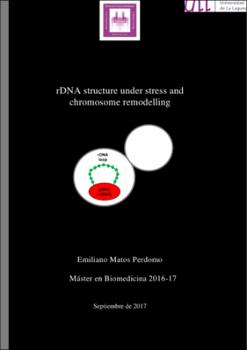rDNA structure under stress and chromosome remodelling
Fecha
2018Resumen
Chromosome structure in the yeast Saccharomyces cerevisiae is only visible at the
microscopic level in the chromosome XII. The ribosomal DNA (rDNA) located in the
long arm of this chromosome has been used to observed different phenomena of
compaction, segregation and chromosomal structure at different phases of the cell cycle.
The metaphase structure (“loop”) depends, among others, on the condensin complex;
and its segregation during anaphase depends also in that complex and on the cell cycle
phosphatase Cdc14. This study aims to elucidate chromosome remodelling under heatstress and other stresses and the influence of Cdc14 and the TOR pathway in this process.
For this, I used different tagged proteins that bind to the rDNA locus for their monitoring
and visualization with fluorescent microscopy under heat-stress conditions, besides, I
applied several molecular and immunological techniques. I employed an auxin based
degron system to degraded proteins by the proteasome. I found that the rDNA
chromosome structure is condensed under heat-stress conditions and TORC1 inhibition,
also I verified that the auxin mediated degradation system is a useful tool for this
purpose. Finally, a role for TORC1 signalling pathway on the stress mediated
condensation process, was established. La estructura cromosómica en Saccharomyces cerevisiae solo es visible a nivel
microscópico en el cromosoma XII. El DNA ribosomal (rDNA) situado en el brazo largo
de dicho cromosoma ha sido usado para observar fenómenos de compactación,
segregación y estructuración cromosómica en diferentes fases del ciclo celular. La
estructura tipo en metafase (“loop”) depende, entre otros, del complejo de la condensina;
y para su segregación en anafase, ese mismo complejo y la fosfatasa de ciclo celular
Cdc14 resultan esenciales. Este trabajo tiene como objetivo dilucidar la remodelación
cromosómica bajo condiciones de estrés térmico y otros estreses, y la influencia de
Cdc14 y la ruta TOR en dicho proceso. Para ello usé proteínas marcadas que se unen al
rDNA para su seguimiento y visualización bajo microscopía de fluorescencia en
condiciones de estrés térmico y otros estreses, además usé diferentes técnicas
moleculares, e inmunológicas. Apliqué el uso de un sistema de degradación de proteínas
por el proteasoma mediado por la auxina. Encontré que la estructura cromosómica del
rDNA se condensa bajo estrés térmico e inhibición de TORC1, además verifiqué que el
uso del sistema de degradación mediado por auxina es útil. Por último, se establece un
papel de TORC1 sobre el proceso de condensación mediada por estrés.




